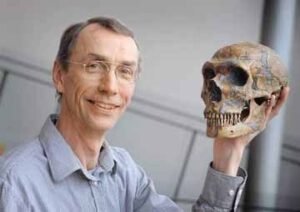
खोजा क्या है…
आज के समय विज्ञान मानता है कि, आधुनिक मानव यानि होमो सेपियंस यानि हम लोग इस धरती पर सबसे पहले अफ्रीका में 300000 साल पहले दिखाई दिए थे. लेकिन, हमसे पहले एक अन्य मानव प्रजाति अफ्रीका से बाहर विचरण कर रही थी. यह प्रजाति थी ‘नियंडरथल मानवों’ की. ‘नियंडरथल मानव’ 400000 लाख साल पहले धरती पर आये थे और यूरोप व एशिया के अधिकतर भूभाग में फैले हुए थे. लगभग 70000 साल पहले आधुनिक मानवों ने अफ्रीका से एशिया की धरती पर कदम रखा था. आज से 30000 हजार साल पहले नियंडरथल मानव विलुप्त हो गए. तो इसका मतलब यह हुआ कि लगभग 40000 साल तक होमो सेपियंस और नियंडरथल मानव एक साथ यूरोप और एशिया में विचरण कर रहे थे. वर्ष 1990 के दशक में वैज्ञानिकों ने मानव के जेनेटिक कोड को देखना शुरू किया. इसके लिए नए नए औजार और नई तकनीकें विकसित हो रही थी.
डॉ. स्वांते पेबो ने इन्हीं औजारों और तकनीकों की मदद से नियंडरथल मानव के जेनेटिक कोड का अध्ययन करने करने लगे. लेकिन, ये तकनीकें नियंडरथल मानव के डीएनए को समझने के लिए कारगर सिद्ध नहीं हो रही थीं. क्योंकि, नियंडरथल का डीएनए पूर्ण अवस्था में मिलता ही नहीं था. म्युनिख विश्वविद्यालय में काम करते हुए डॉ. पेबो ने माईटोकॉन्डरिया (हमारी कोशिकाओं में मौजूद एक विशेष संरचना जिसे कोशिका का पावर हाउस भी कहा जाता है) में मौजूद डीएनए का अध्ययन करने पर ध्यान केंद्रित किया. हालांकि, माईटोकॉन्डरिया के डीएनए में कोशिका के डीएनए से कम जानकारी होती है लेकिन नियंडरथल के केस में यह कोशिका के डीएनए से ज्यादा अच्छी हालत में मिल रहा था इसलिए सफलता की संभावना ज्यादा हो गई थी.
अपनी नई तकनीक के द्वारा पेबो ने नियंडरथल मानव की एक 40000 हजार साल पुरानी हड्डी के माईटोकॉन्डरिया के डीएनए का सीक्वेन्स बनाने में सफलता हासिल कर ली. और यह पहला सबूत था जो यह बताता है कि आधुनिक मानव नियंडरथल से जेनेटिक तौर पर भिन्न है. यानि यह एक भिन्न प्रजाति है. वर्ष 2010 में पेबो और उनकी टीम ने नियंडरथल का पहला जेनेटिक सीक्वेन्स छापा. पेबो की इस खोज ने हमें यह बताया कि आज से आठ लाख साल पहले हमारा यानि होमो सेपियंस और नियंडरथल मानव का एक कॉमन पूर्वज इस धरती पर था. पेबो और उनकी टीम को आधुनिक मानव के डीएनए में नियंडरथल के डीएनए के अंश भी मिले जिससे यह पता चलता है आधुनिक मानव और नियंडरथल मानव के बीच में इंटरब्रीडिंग होती रही है.
लेकिन सिर्फ यही काफ़ी नहीं था. पेबो को दक्षिणी साइबेरिया की एक गुफा में 40000 साल पुरानी इंसानी ऊँगली की हड्डी मिली थी. जब पेबो ने इसकी डीएनए सीक्वेन्सिंग की तो उन्हें कुछ ऐसा मिला जोकि आज तक किसी को नहीं मिला था. इस हड्डी का डीएनए न तो नियंडरथल के डीएनए से मिलता था और न ही आधुनिक मानव के डीएनए से. यह मानव की एक सर्वथा नई प्रजाति थी. इस नई प्रजाति को डेनिसोवा नाम दिया गया क्योंकि जिस जगह यह हड्डी मिली थी उस जगह को डेनिसोवा ही कहा जाता है. डेनिसोवा और नियंडरथल लगभग 600000 साल पहले एक दूसरे से अलग हुए थे.लेकिन, अभी एक महत्वपूर्ण खोज और बाक़ी थी. दक्षिण पूर्व एशिया के लोगों में से 6% में डेनिसोवा मानव के डीएनए के अंश भी मिले हैं, जिससे पता चलता है कि इन दोनों समूहों के बीच भी सम्पर्क रहा होगा. बहरहाल इन खोजों ने हमारे पूर्वजों के बारे में हमारी जानकारी को विकसित किया है. साथ ही इनसे हमारी रोग प्रतिरोधक क्षमता के विकास को समझने में भी मदद मिली है. तीस साल पहले शुरू हुई विज्ञान की इस नई शाखा ने अब फल देने शुरू किये हैं, उम्मीद है कि आगे भी मानव अपने ज्ञान का दायरा बढ़ाता रहेगा. इसके अलावा एक और बात. डॉ. स्वांते पेबो वर्ष 1982 के फिजियोलॉजी मेडिसिन के नोबेल पुरस्कार विजेता सुनये बेर्गस्त्रोम के पुत्र हैं. सुनये बेर्गस्त्रोम को नोबेल पुरस्कार प्रोस्टाग्लैंडिन नामक एक बायोकेमिकल के ऊपर उनके काम के लिए मिला था.
============ ============ ===============
What is the search…
 Today’s science believes that modern humans i.e. Homo sapiens i.e. first appeared on this earth in Africa 300000 years ago. But, before us, another human species was wandering out of Africa. This species was of ‘Neanderthal humans’. ‘Neanderthal humans’ came to the earth 400000 million years ago and were spread over most of the land of Europe and Asia. About 70,000 years ago, modern humans set foot on the land of Asia from Africa. Neanderthal humans became extinct 30000 thousand years ago. So this means that for about 40,000 years, Homo sapiens and Neanderthal humans were roaming in Europe and Asia together. In the year 1990, scientists started looking at the genetic code of humans. For this, new tools and new techniques were being developed.
Today’s science believes that modern humans i.e. Homo sapiens i.e. first appeared on this earth in Africa 300000 years ago. But, before us, another human species was wandering out of Africa. This species was of ‘Neanderthal humans’. ‘Neanderthal humans’ came to the earth 400000 million years ago and were spread over most of the land of Europe and Asia. About 70,000 years ago, modern humans set foot on the land of Asia from Africa. Neanderthal humans became extinct 30000 thousand years ago. So this means that for about 40,000 years, Homo sapiens and Neanderthal humans were roaming in Europe and Asia together. In the year 1990, scientists started looking at the genetic code of humans. For this, new tools and new techniques were being developed.
Dr. Swante Pebo started studying the genetic code of Neanderthal humans with the help of these tools and techniques. But, these techniques were not proving effective in understanding the DNA of Neanderthal humans because Neanderthal’s DNA was not found in complete condition. While working at the University of Munich, Dr. Pebo focused on studying the DNA contained in the mitochondria (a specialized structure in our cells that is also known as the powerhouse of the cell). Although the DNA of the mitochondria contains less information than the DNA of the cell, in the case of the Neanderthal it was found in a better condition than the DNA of the cell, so the chances of success were higher.
Through his new technique, Pebo succeeded in making a sequence of DNA of mitochondria of a 40000 thousand-year-old bone of Neanderthal man. And this was the first evidence that suggests that modern humans are genetically different from Neanderthals. That is, it is a different species. In 2010, Pebo and his team published the first genetic sequence of Neanderthals. This discovery of Pebo told us that a common ancestor of ours i.e. Homo sapiens and Neanderthal man was on this earth eight million years ago. Pebo and his team also found traces of Neanderthal DNA in the DNA of modern humans, suggesting that interbreeding between modern humans and Neanderthals took place.
But this alone was not enough. Pebo found a 40,000-year-old human finger bone in a cave in southern Siberia. When Pebo did its DNA sequencing, he found something that no one had found to date. The DNA of this bone was neither found with the DNA of Neanderthals nor with the DNA of modern humans. It was an entirely new species of human. This new species was named Denisova because the place where this bone was found is called Denisova itself. Denisova and Neanderthals diverged from each other about 600,000 years ago. But, there was still one important discovery left. Traces of DNA from Denisova humans have also been found in 6% of people from Southeast Asia, suggesting that there may have been contacting between these two groups. However, these discoveries have developed our knowledge about our ancestors. Along with this, they have also helped in understanding the development of our immunity. This new branch of science, which started thirty years ago, has now started bearing fruits, and it is expected that human beings will continue to increase the scope of their knowledge in the future. Also one more thing. Dr. Swante Pebo is the son of the 1982 Nobel Prize winner in Physiology or Medicine, Sunay Bergstrom. Sunay Bergstrom received the Nobel Prize for his work on a biochemical called prostaglandin.
Prabhakar Kumar.





